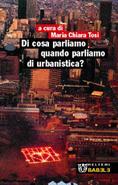Cohesion open spaces urban africa open position periodic news inu housing ecology demography urban practices special news rural areas regulation citizenship globalization habitability urban renewal sprawl welfare tools and techniques social practices urban regeneration urban projects culture public policies
Di cosa parliamo quando parliamo di urbanistica? Review
by Cristina Renzoni
Borrowing its title from a collection of short stories by Raymond Carver published in 1981 - What we talk about when we talk about love - the book edited by Maria Chiara Tosi immediately shows its focus: the need to ask what urbanism is today and what it deals with.
What do we talk about when we talk about urbanism? This is the question that lies behind the fourteen essays, collected in the book in alphabetical order and written by Paolo Avarello, Angela Barbanente, Attilio Belli, Alberto Clementi, Pier Luigi Crosta, Giulio Ernesti, Patrizia Gabellini, Karl Kupka, David Mangin, Luigi Mazza, Pier Carlo Palermo, Josep Parcerisa, Bernardo Secchi and Guido Zucconi. These professionals, practicians, academics and theorists look at urbanism from different points of view, and propose different interpretations of what this "field of practices and knowledges with permeable borders" is about.
The authors organize their arguments by means of definitions, city tales, interpretations of books, presentations of case studies, letters: they make use of different strategies and answer more or less directly to the original question, dealing with the openings and delimitations of a pluri-dimensional knowledge (both theoretical and practical) that rests on the uncertain ground of urban transformation.
In their writings Pier Carlo Palermo and Alberto Clementi focus on urbanism's "evolutive tendencies" and on the necessity of new professional figures, as a "possible and right extension" of a practical knowledge that brings together a wide variety of "considerably renewed" professionalisms.
Guido Zucconi proposes a distinction between proper and unproper planning, and writes about urbanism's double identity, on the one hand "a science of planning", on the other hand "a complex system, not always coherent, of efforts coming from different directions".
A few essays deal with the way urbanism can recognize questions and needs put forward by different subjects: David Mangin describes three ways of talking about urbanism, referring to places and people; Angela Barbanente focuses on expectations and consolidated images stratified by common sense around this discipline.
Luigi Mazza discusses such issues as borders, spatial and social control, and territoriality, moving from an analysis of "two myths and archetypes": the stories of Ippodamo and Romolo, taken as "metaphors of making urbanism". He selects four basic key-words (dividing, distinguishing, ordering and distributing) which refer to distinctive and typical actions of a professional knowledge based, first of all, on the ground regulation, "where the object of regulation is not the city, but the uses of the ground".
Patrizia Gabellini considers urbanism as a "practical knowledge" applied to the "transformation project" for a specific "urbanized territory", and discusses two recent research experiences which serve as indirect definitions: her book Tecniche urbanistiche and a case study, the Jesi plan, "tailored clothes made to fit the context".
Following urbanism's "long history", Bernardo Secchi organizes his tale analyzing the many changes that brought urbanism to operate a re-definition of its own perspective, its "social engagements", its "fundamental propositions", its "ways of observation", its project's nature.
In her introduction Maria Chiara Tosi isolates and organizes the more relevant matters that lie behind this broad collection of essays: re-proposing the structure of question and answer, she builds comparisons and cross-sectional readings among the different contributions. What emerges is an interesting map of the current trends of urbanism, in Italy and abroad: not an unlikely attempt to outline a synthesis, but a focus on some themes that play a central role in the practice of urbanism today.
This is a review for:
[Book] Di cosa parliamo quando parliamo di urbanistica?
by edited by Maria Chiara Tosi
Related articles:




Planum
The Journal of Urbanism
ISSN 1723-0993
owned by
Istituto Nazionale di Urbanistica
published by
Planum Association
ISSN 1723-0993 | Registered at Court of Rome 4/12/2001, num. 514/2001
Web site realized by ChannelWeb & Planum Association | Powered by BEdita 3

